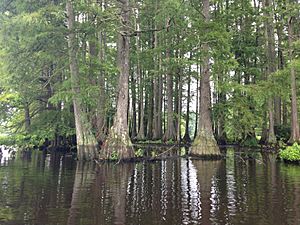Great Cypress Swamp facts for kids

The Great Cypress Swamp, also known as the Great Pocomoke Swamp or Cypress Swamp, is a large, watery forest. You can find it on the Delmarva Peninsula in southern Delaware and southeastern Maryland. As of 2000, it was the biggest continuous forest in this area.
Located at 38°29′N 75°18′W / 38.483°N 75.300°W, it is one of the most northern places where you can find bald cypress swamps. These types of swamps are more common in the southeastern United States. The Great Cypress Swamp covers about 50 square miles (about 130 square kilometers). Most of it is in southern Sussex County, Delaware. This swamp is also where the Pocomoke River begins, flowing south, and Pepper Creek, which flows northeast.
History of the Great Cypress Swamp
This swamp was once a major source of cypress wood. However, too much logging and a terrible peat fire in 1930 destroyed much of its plant life. One of these fires burned for eight months! Because of this, local people started calling it the "Burnt Swamp."
In 1980, Senator Joe Biden suggested turning the swamp into a National Park. He did this because environmental groups asked him to. But local residents were worried about too many visitors coming to their area. So, this plan did not go forward. When Senator Tom Carper thought about creating a national park in Delaware again in 2004, the Cypress Swamp was not considered because of these past concerns.
Today, a non-profit group called Delaware Wild Lands helps manage the swamp. They have been working hard to replant bald cypress trees there.
Wildlife in the Swamp
The Great Cypress Swamp is a very important home for many animals. It provides a safe place for them to live and raise their young.
Birds of the Cypress Swamp
The swamp is home to 73 different kinds of birds that breed there. This means they build nests and have their babies in the swamp. Some of the most common birds you might see are the worm-eating warbler and the brown-headed cowbird. The swamp also has two types of birds that are rare in the region: Swainson's warbler and black-throated green warbler. Bird watchers using eBird have recorded at least 94 different bird species in the swamp. Some of these birds are just passing through during migration and do not breed there.

